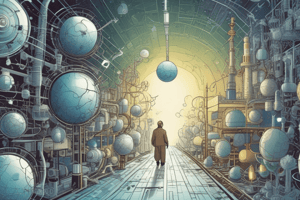Podcast
Questions and Answers
[Blank] is the study of the natural world through observation and experimentation.
[Blank] is the study of the natural world through observation and experimentation.
Science
A ______ is a testable explanation or prediction.
A ______ is a testable explanation or prediction.
hypothesis
[Blank] is the process of assigning numbers to observations.
[Blank] is the process of assigning numbers to observations.
Measurement
[Blank] is anything that has mass and takes up space.
[Blank] is anything that has mass and takes up space.
[Blank] energy is the energy of motion.
[Blank] energy is the energy of motion.
[Blank] is a push or a pull.
[Blank] is a push or a pull.
[Blank] is the bouncing of light off a surface.
[Blank] is the bouncing of light off a surface.
[Blank] is the flow of electric charge.
[Blank] is the flow of electric charge.
[Blank] is a force of attraction or repulsion between objects.
[Blank] is a force of attraction or repulsion between objects.
The Earth ______ on its axis, causing day and night.
The Earth ______ on its axis, causing day and night.
Flashcards
What is Science?
What is Science?
The study of the natural world based on observation and experimentation.
Scientific Method
Scientific Method
A systematic approach to solving problems using observation, questioning, hypothesis, experimentation, analysis, and conclusion.
What is Matter?
What is Matter?
Anything that has mass and takes up space.
What is Energy?
What is Energy?
Signup and view all the flashcards
What is Force?
What is Force?
Signup and view all the flashcards
What is Gravity?
What is Gravity?
Signup and view all the flashcards
What is Reflection?
What is Reflection?
Signup and view all the flashcards
What is Sound?
What is Sound?
Signup and view all the flashcards
What is Electricity?
What is Electricity?
Signup and view all the flashcards
What is an Ecosystem?
What is an Ecosystem?
Signup and view all the flashcards
Study Notes
- Science is the study of the natural world through observation and experimentation
- Science aims to explain how the world works
Scientific Method
- The scientific method is a systematic approach to solving problems
- Steps include observation, asking a question, forming a hypothesis, experimenting, analyzing data, and drawing conclusions
- Observation involves using the senses to gather information
- A question arises from observations and identifies the problem
- A hypothesis is a testable explanation or prediction
- Experiments test the hypothesis by changing one variable and observing the effect on another
- Data analysis involves organizing and interpreting the results of the experiment
- Conclusions state whether the hypothesis was supported or not
Measurement
- Measurement is the process of assigning numbers to observations
- Standard units of measurement include meters (length), kilograms (mass), seconds (time)
- Tools for measurement include rulers, balances, and stopwatches
Matter
- Matter is anything that has mass and takes up space
- States of matter include solid, liquid, gas, and plasma
- Solids have a definite shape and volume
- Liquids have a definite volume but take the shape of their container
- Gases have no definite shape or volume
- Plasma is a superheated gas with ionized particles
- Changes of state occur when matter absorbs or releases energy
- Melting is the change from solid to liquid
- Freezing is the change from liquid to solid
- Boiling is the change from liquid to gas
- Condensation is the change from gas to liquid
- Sublimation is the change from solid to gas
- Deposition is the change from gas to solid
Energy
- Energy is the ability to do work
- Forms of energy include kinetic, potential, thermal, chemical, electromagnetic, and nuclear
- Kinetic energy is the energy of motion
- Potential energy is stored energy
- Thermal energy is the energy of heat
- Chemical energy is stored in the bonds of molecules
- Electromagnetic energy includes light, radio waves, and X-rays
- Nuclear energy is stored in the nucleus of an atom
- Energy can be converted from one form to another
- Energy is measured in joules
Force and Motion
- Force is a push or a pull
- Forces can cause objects to start moving, stop moving, or change direction
- Gravity is the force of attraction between objects with mass
- Friction is a force that opposes motion
- Motion is a change in position over time
- Speed is the rate at which an object is moving
- Velocity is speed with direction
- Acceleration is the rate of change of velocity
- Newton's laws of motion describe the relationship between force, mass, and acceleration
- Newton's first law states that an object at rest stays at rest and an object in motion stays in motion with the same speed and direction unless acted upon by a force
- Newton's second law states that the acceleration of an object is directly proportional to the net force acting on it and inversely proportional to its mass (F=ma)
- Newton's third law states that for every action, there is an equal and opposite reaction
Light
- Light is a form of electromagnetic radiation
- Light travels in waves
- The color of light is determined by its wavelength
- The visible spectrum includes the colors red, orange, yellow, green, blue, indigo, and violet
- Light can be reflected, refracted, and absorbed
- Reflection is the bouncing of light off a surface
- Refraction is the bending of light as it passes from one medium to another
- Absorption is the taking in of light by an object
Sound
- Sound is a form of energy that travels in waves
- Sound waves are caused by vibrations
- Sound travels through solids, liquids, and gases
- The speed of sound depends on the medium
- The pitch of sound is determined by its frequency
- The loudness of sound is determined by its amplitude
- Sound can be reflected, refracted, and absorbed
- Echoes are reflected sound waves
Electricity
- Electricity is the flow of electric charge
- Electric charge is carried by electrons and protons
- Like charges repel, and opposite charges attract
- Electric current is the rate of flow of electric charge
- Voltage is the electrical potential difference
- Resistance is the opposition to the flow of electric current
- Electric circuits provide a path for electric current to flow
- Series circuits have one path for current to flow
- Parallel circuits have multiple paths for current to flow
- Conductors allow electric current to flow easily
- Insulators resist the flow of electric current
Magnetism
- Magnetism is a force of attraction or repulsion between objects
- Magnets have two poles, north and south
- Like poles repel, and opposite poles attract
- Magnetic fields surround magnets
- Electromagnets are created by running electric current through a wire
- Electric motors use electromagnets to convert electrical energy into mechanical energy
- Generators use magnets to convert mechanical energy into electrical energy
Simple Machines
- Simple machines make work easier by changing the magnitude or direction of the force
- Types of simple machines include levers, pulleys, wheels and axles, inclined planes, wedges, and screws
- Levers use a rigid bar that pivots around a fulcrum to multiply force
- Pulleys use a rope and wheel to change the direction of force
- Wheels and axles use a wheel attached to a central bar to multiply force
- Inclined planes reduce the force needed to raise an object by increasing the distance
- Wedges are used to split or separate objects
- Screws are inclined planes wrapped around a cylinder
The Earth
- The Earth is the third planet from the sun
- The Earth is composed of layers: crust, mantle, outer core, inner core
- The crust is the outermost layer, composed of solid rock
- The mantle is a thick layer of hot, dense rock
- The outer core is liquid iron and nickel
- The inner core is solid iron and nickel
- The Earth rotates on its axis, causing day and night
- The Earth revolves around the sun, causing the seasons
- The Earth has one moon
Weather
- Weather is the state of the atmosphere at a particular time and place
- Elements of weather include temperature, humidity, precipitation, wind, and atmospheric pressure
- Temperature is a measure of how hot or cold something is
- Humidity is the amount of water vapor in the air
- Precipitation is water that falls from the atmosphere in the form of rain, snow, sleet, or hail
- Wind is the movement of air
- Atmospheric pressure is the force exerted by the weight of the atmosphere
- Weather patterns are influenced by air masses, fronts, and pressure systems
Ecosystems
- An ecosystem is a community of living organisms and their physical environment
- Living organisms in an ecosystem include plants, animals, fungi, and bacteria
- The physical environment includes soil, water, air, and sunlight
- Ecosystems are characterized by the flow of energy and the cycling of nutrients
- Energy flows from the sun to producers (plants) to consumers (animals)
- Nutrients cycle through the ecosystem as organisms live, die, and decompose
- Food chains show the transfer of energy from one organism to another
- Food webs show the interconnected food chains in an ecosystem
Plants
- Plants are living organisms that produce their own food through photosynthesis
- Plant parts include roots, stems, leaves, and flowers
- Roots anchor the plant and absorb water and nutrients from the soil
- Stems support the plant and transport water and nutrients
- Leaves are the site of photosynthesis
- Flowers are the reproductive structures of plants
- Photosynthesis is the process by which plants use sunlight, water, and carbon dioxide to produce sugar and oxygen
- Plants reproduce sexually and asexually
Animals
- Animals are living organisms that consume other organisms for food
- Animals are classified into different groups based on their characteristics
- Vertebrates have a backbone
- Invertebrates do not have a backbone
- Mammals are warm-blooded vertebrates with fur or hair that feed their young milk
- Birds are warm-blooded vertebrates with feathers that lay eggs
- Reptiles are cold-blooded vertebrates with scales that lay eggs
- Amphibians are cold-blooded vertebrates that live in water and on land
- Fish are cold-blooded vertebrates that live in water and have gills
- Insects are invertebrates with three body segments and six legs
Human Body
- The human body is made up of organ systems that work together to maintain life
- Organ systems include the skeletal, muscular, nervous, circulatory, respiratory, digestive, excretory, and reproductive systems
- The skeletal system provides support and protection
- The muscular system enables movement
- The nervous system controls and coordinates body functions
- The circulatory system transports blood, oxygen, and nutrients
- The respiratory system enables gas exchange
- The digestive system breaks down food
- The excretory system removes waste
- The reproductive system enables reproduction
Studying That Suits You
Use AI to generate personalized quizzes and flashcards to suit your learning preferences.




